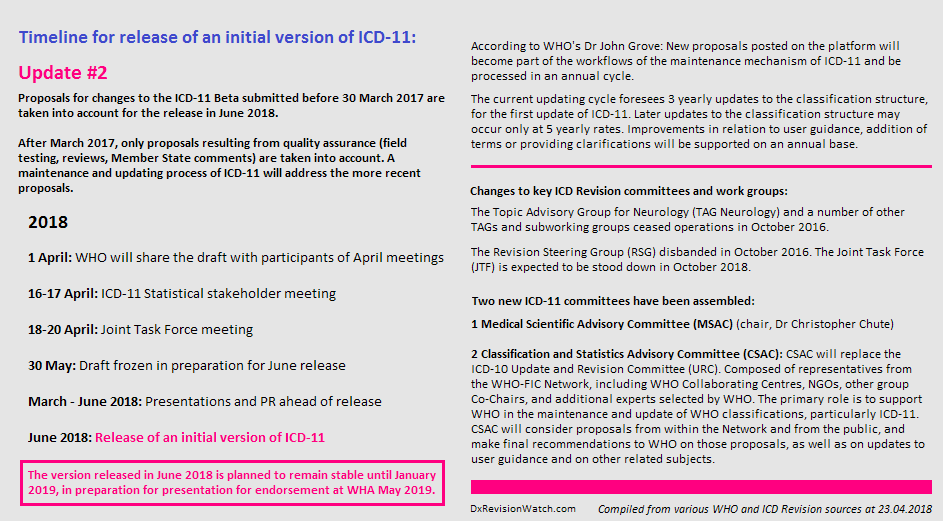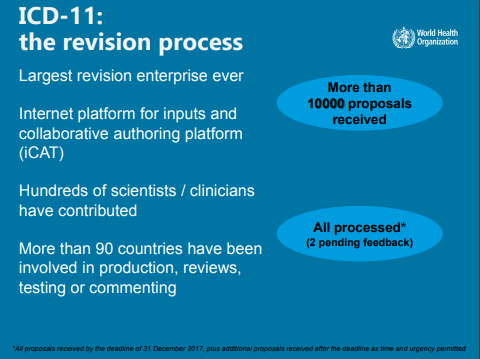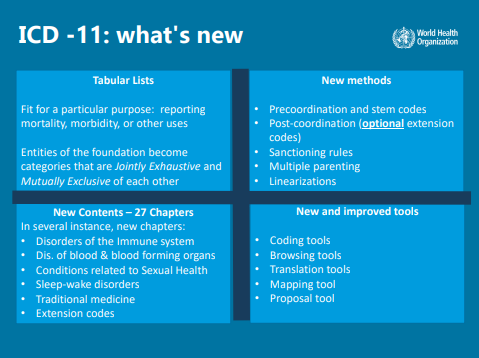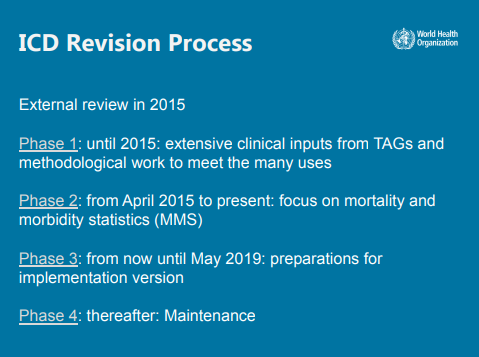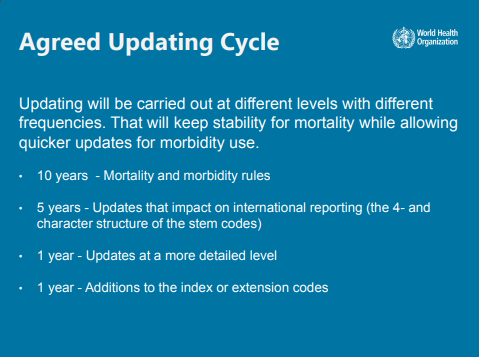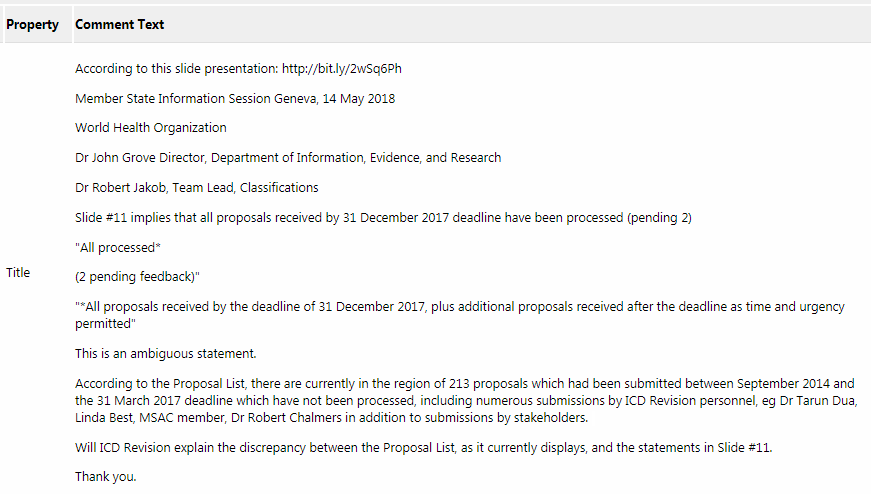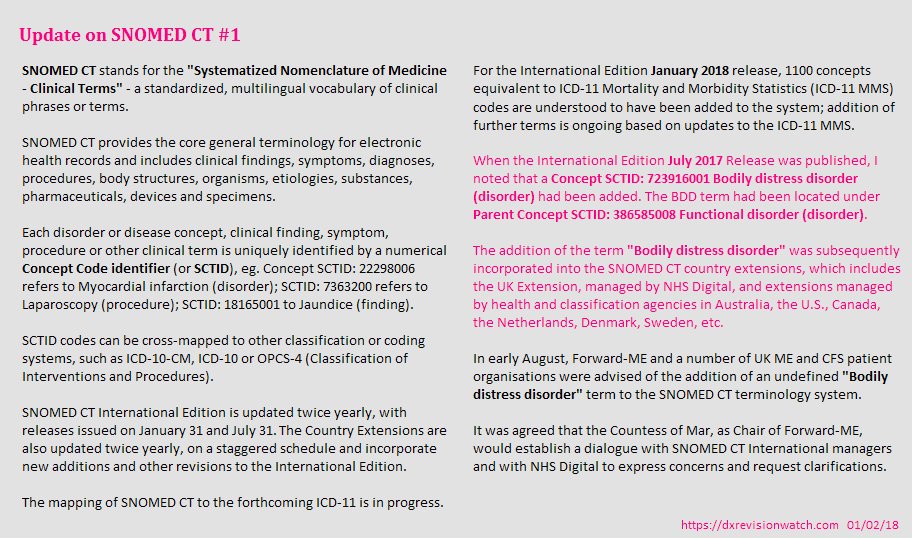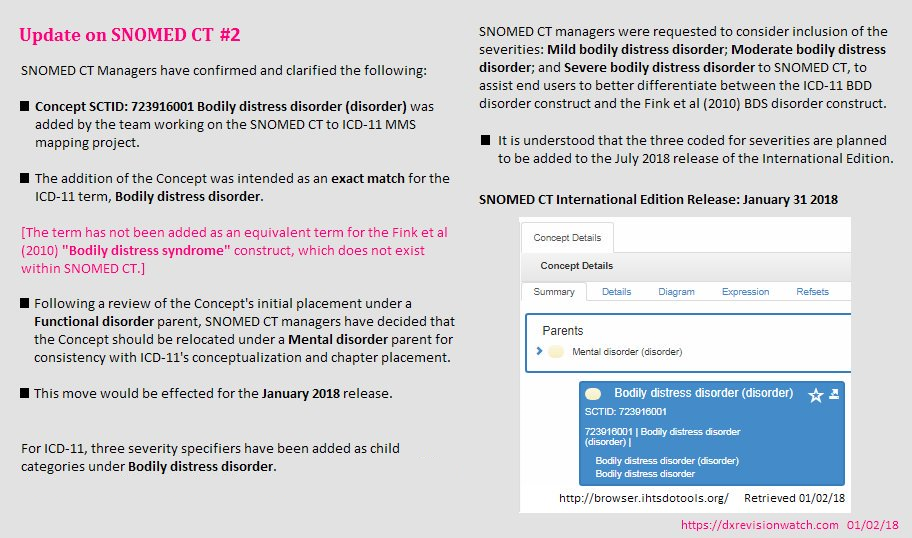This is the third in a series of posts about SNOMED CT:
Post #3 Inclusion of ICD-11's Bodily distress disorder
Post #1 Introduction to SNOMED CT clinical terminology system
Post #2 Concept terms of interest to us
Post #4 Change of Parent for Chronic fatigue syndrome and its Synonym terms
Post #5 Confirmation of change of Parent for CFS and its Synonym terms (to be posted on July 31, 2018)
Summary: Inclusion of ICD-11's Bodily distress disorder in SNOMED CT
Expanded version: Inclusion of ICD-11's Bodily distress disorder in SNOMED CT
Most of the ICD-10
Somatoform disorders categories and
Neurasthenia are being replaced for ICD-11 by
Bodily distress disorder (BDD), a single new category which was added to the Beta draft in February 2012.
The BDD diagnostic construct, as described and characterized by the
Somatic Distress and Dissociative Disorders Working Group (S3DWG) has been the only construct under consideration for the core ICD-11 edition since it was first added to the Beta draft, six years ago.
The conceptualization, characterization and criteria for the core ICD-11's
Bodily distress disorder are very close to DSM-5's
Somatic symptom disorder (SSD), and
Somatic symptom disorder is listed under
Synonyms to BDD.
Although the term
"Bodily distress disorder" is often used interchangeably for the Fink et al (2010)
Bodily distress syndrome (BDS) diagnostic construct, the core ICD-11's
Bodily distress disorder is differently defined and characterized, has a very different criteria set and captures a different patient population [1].
Bodily distress disorder added to SNOMED CT terminology system in July 2017:
The International Edition of SNOMED CT releases two updates per year, on January 31 and July 31. Changes in the most recent International release (which may run to thousands of additional Concepts and changes to existing content) are subsequently incorporated into the various National Editions when they release their next updated versions.
In August 2017, I noticed that the SNOMED CT International Edition release for July 31 included an (undefined)
Bodily distress disorder Concept term.
Concept:
SCTID: 723916001 Bodily distress disorder (disorder) had been assigned under
Parent: Functional disorder (disorder).
Forward-ME and a number of UK patient organizations were advised of this addition.
There is an MoU between
SNOMED International and the WHO to work towards alignment between SNOMED CT content and the content proposed in ICD-11. New ICD-11 terms are gradually being incorporated into SNOMED CT releases and a coding cross map between the two systems is in progress.
It was conceivable that
ICD Revision had submitted for the addition of
Bodily distress disorder as part of the alignment process.
However, given the concerns around both BDD and BDS and with no definition or description text for Concept: SCTID: 723916001 Bodily distress disorder (disorder), it was important to determine what
SNOMED International terminology managers understood by the term and to also establish who had submitted the request for its addition to the terminology system, and on the basis of what supportive evidence.
Following discussions with
Action for M.E.'s Sonya Chowdhury and the Countess of Mar, it was agreed that an approach would be made to
SNOMED International's terminology managers, on behalf of
Forward-ME, to request specific clarifications regarding the conceptualization and provenance of this new Concept addition, and that a draft letter would first be circulated to the various
Forward-ME organization reps for their review and approval.
The terminology leads were also provided with information about DSM-5's SSD, the differences between ICD-11's BDD and the Fink et al (2010) BDS diagnostic construct, and with other relevant information and concerns.
In October 2017,
SNOMED International's Head of Terminology clarified that:
- Bodily distress disorder had been added by the team working on the SNOMED CT and ICD-11 MMS Mapping Project;
- The term had been added as "an exact match" for ICD-11 term, Bodily distress disorder;
- The term had not been added as the equivalent for the Fink et al (2010) Bodily distress syndrome disorder construct, which does not currently exist within SNOMED CT.
Having reviewed the information provided, the terminology managers decided that the SNOMED CT BDD Concept would be more accurately assigned under
Parent: SCTID: 74732009 Mental disorder (disorder), for consistency with ICD-11's conceptualization and chapter placement.
Concept: SCTID: 723916001 Bodily distress disorder (disorder) was removed from under
Parent: SCTID: 386585008 Functional disorder (disorder) and relocated under
Parent: SCTID: 74732009 Mental disorder (disorder) for the International Edition's January 31, 2018 release.
This change has subsequently been incorporated into the various National Editions.
SNOMED CT terminology system does not have exclusion terms as are used in ICD-10 and ICD-11. So submitting a request for exclusions for PVFS, ME and CFS under SNOMED CT's
Bodily distress syndrome wasn't an option.*
*Dimmock and Chapman submitted proposals for exclusions for PVFS, CFS and ME under ICD-11's Bodily distress disorder, in March 2017, which have not yet been processed.
Addition of BDD's three severity specifiers:
During further correspondence between the Countess of Mar (on behalf of
Forward-ME) and the terminology managers, it was discussed what other safeguards might be put in place to mitigate the risk of confusion and conflation between SNOMED CT's BDD and the Fink et al (2010) construct, in clinical application and recording of statistics for data analysis.
In ICD-11,
Bodily distress syndrome has three severities of psychobehavioural responses which are discretely coded for and each assigned a unique Description/characterization text.
It was advanced that inclusion within SNOMED CT of the three severity specifiers might assist clinicians, coders and other end users in distinguishing between the SNOMED CT/ICD-11
Bodily distress disorder concept and the similarly named,
Bodily distress syndrome, as defined by Fink et al (2010), which has just two severities and which are differently characterized.
A request for addition of the three ICD-11 severity specifiers was submitted and approved and the specifiers (
Mild bodily distress syndrome;
Moderate bodily distress syndrome; and
Severe bodily distress syndrome) are scheduled to be added to the July 31, 2018 release, under
Children to
Concept: SCTID: 723916001 Bodily distress disorder (disorder).
ICD-10:
There is no
Bodily distress disorder in ICD-10. Other than correction of errors, the last update for ICD-10 is currently scheduled for 2019 (though member states will continue to record data using ICD-10 until they are ready to migrate to ICD-11 or to a clinical modification of ICD-11).
There are mappings between ICD-10 and SNOMED CT and in the SNOMED CT UK Edition,
SCTID: 723916001 Bodily distress disorder (disorder) is mapped to ICD-10
F45.9 Somatoform disorder, unspecified [2].
References:
1 ICD-11 Beta draft: Rationale for Proposal for Deletion of proposed new category: Bodily distress disorder, Suzy Chapman, March 1, 2017:
https://dxrevisionwatch.com/2017/03...oposed-new-category-bodily-distress-disorder/
2 SNOMED CT UK Edition browser:
https://termbrowser.nhs.uk/
SNOMED CT UK Edition is released twice per year and consists of the International Edition content plus UK specific content provided within the UK Clinical Extension and for use in the UK only. Note that the NHS Digital SNOMED CT Browser is updated in line with the SNOMED CT UK Edition release schedule and will not always align with content in the most recent SNOMED CT International Edition release.



